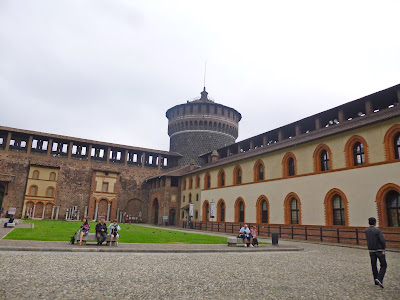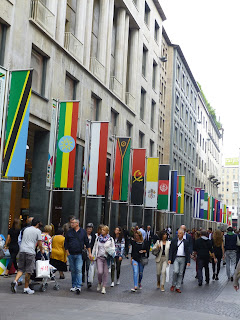Monday morning I will spend the day in Milano. Loretta has left early to work. She teaches at the Universita Catolica Sacro Cuore, where I will meet her later.
Alessandro drives me to Gallarate where I take the train to Milano Stazione Garibaldi, from there I take the metro to the Piazza del Duomo.
 |
| Main entrance of the Galeria Vittorio Emanuele II. |
On my walk toward the University I pass the Piazza Borromeo

 |
| La chiesa di Santa Maria Podone |
 |
| Università Cattolica del Sacro Cuore |
I visit some of the buildings together with Loretta, and then we set off on our city walk.
In the Via Brisa you can see the vestiges of the Imperial Palace.
 |
| Torre del Filarete |
 |
| Torre di Bona & Pza d'Armi |
The various museums located in the Castello are closed on Mondays, but the site is quite spectacular.
 |
| Torre di Santa Spirito |

 |
| Cortila delle Rocchetta |




 We take the Via Dante back to the Duomo, as we plan to have lunch on the roof restaurant of the Rinascenti, with view on the Duomo.
We take the Via Dante back to the Duomo, as we plan to have lunch on the roof restaurant of the Rinascenti, with view on the Duomo. |
| La Galleria Vittorio Emmanuele II |



 |
| Lunch op terras Rinascenti |
 |
| Corso Vittoria Emmanuele II |

 |
| Chiesa di San Carlo al Corso (Carolo Borromeo) at the Piazza San Babila (San Carlo) |

 |
| Savini, definitely the nicest coffee bar in the World |

 |
| Teatro alla Scala |
The Teatro alla Scala was founded, under the auspices of the Empress Maria Theresa of Austria, to replace the Royal Ducal Theatre, which was destroyed by fire on 26 February 1776 and had until then been the home of opera in Milan. The cost of building the new theatre was borne by the owners of the boxes at the Ducal, in exchange for possession of the land on which stood the church of Santa Maria alla Scala (hence the name) and for renewed ownership of their boxes. Designed by the great neoclassical architect Giuseppe Piermarini, La Scala opened on 3 August 1778 with Antonio Salieri's opera L'Europa riconosciuta, to a libretto by Mattia Verazi.


 |
| Giuseppi Verdi |
 |
| Gaetano Donizetti |







 |
| Il Palazzo Mezzanote (La Borsa) |
L.O.V.E., comunemente nota come “Il Dito” è una scultura posta al centro di Piazza degli Affari, opera dell'artista italiano Maurizio Cattelan. L'opera è collocata di fronte al Palazzo Mezzanotte, sede della Borsa. Il nome è un acronimo di «libertà, odio, vendetta, eternità». La scultura è alta 4 metri e 60, che diventano 11 complessivi contando il basamento, ed è realizzata in marmo di Carrara.

We now walk back to the Basilica di San Ambrogio, adjacent to the Università.
 The church was originally named after the saints Gervasius and Protasius (aka Gervase and Protase), whose remains were found at the site. After Ambrose died in 397, the church was dedicated to him instead.
The church was originally named after the saints Gervasius and Protasius (aka Gervase and Protase), whose remains were found at the site. After Ambrose died in 397, the church was dedicated to him instead.
At the end of the eighth century, the Benedictines built a convent next to the church. Two centuries later the church had become too small and during the following centuries most of the structure was rebuilt and expanded. In 1492 Donate Bramante started with the construction of the cloisters and a portico, but work was halted when his patron Ludovico Il Moro was ousted from Milan. After it was damaged during bombardments in 1943, Bramante's work was restored and in 1955 it was finally completed by Ferdinando Reggiori.
 |
| The Atrium |
The Church of Sant'Ambrogio is built well below present day's street level and seems tucked away behind the Anspert atrium, which as an entrance courtyard to the church.
Two towers are visible from the atrium. The tallest one on the left is known as the Campanile dei Canonici and was built in the eleventh century. The smaller tower to the right is the Campanile dei Monaci, built by the Benedictines in the eighth century.
The porticos around the atrium were mostly rebuilt after the Second World War. The most interesting is the portico at the narthex, which is decorated with animal motifs and surmounted by a loggia with five arches.
 The church has a solemn and soberly decorated interior. A central cross vaulted nave, typical for Lombardian architecture, is flanked on either side by aisles. Above the aisles are the women's galleries.
The church has a solemn and soberly decorated interior. A central cross vaulted nave, typical for Lombardian architecture, is flanked on either side by aisles. Above the aisles are the women's galleries.
The gold altar was created in the ninth century by Volvinio to hold the remains of Saint Ambrose. It is magnificently decorated with reliefs depicting scenes from the saint and Christ. The baldachin above the altar, also decorated with reliefs, dates from the tenth century and rests upon four porphyry columns, possibly from the original fourth century church.
They were however damaged during the Second World War and are now restored.
The most notable chapel in the church is the chapel of San Vittore in Ciel d'Oro. The chapel was built in the fourth century as a separate structure to hold the remains of Saint Victor, a local martyr who died in 303.
The ceiling of the chapel is decorated with fifth century mosaics depicting the saints Ambrose, Gervase and Protase.
The crypt, located under the high altar, was built in the 9th century to houses the remains of three saints venerated here: Ambrose, Gervasus and Protasus.
The remains of the saints were already in a crypt in the area, although their position went lost with the centuries. In the 9th century bishop Angilbert found them and had them put in a single porphyry sarcophagus.












































